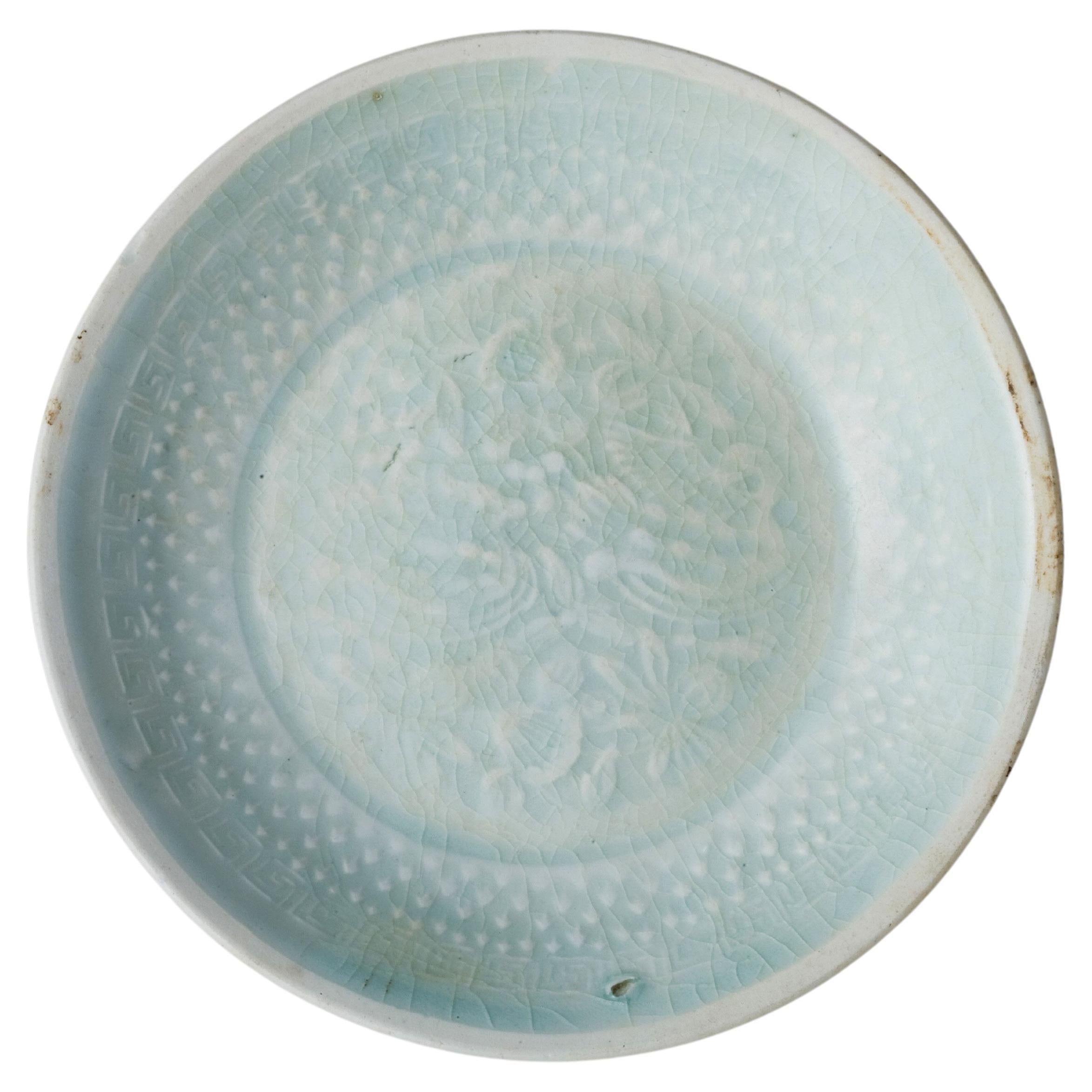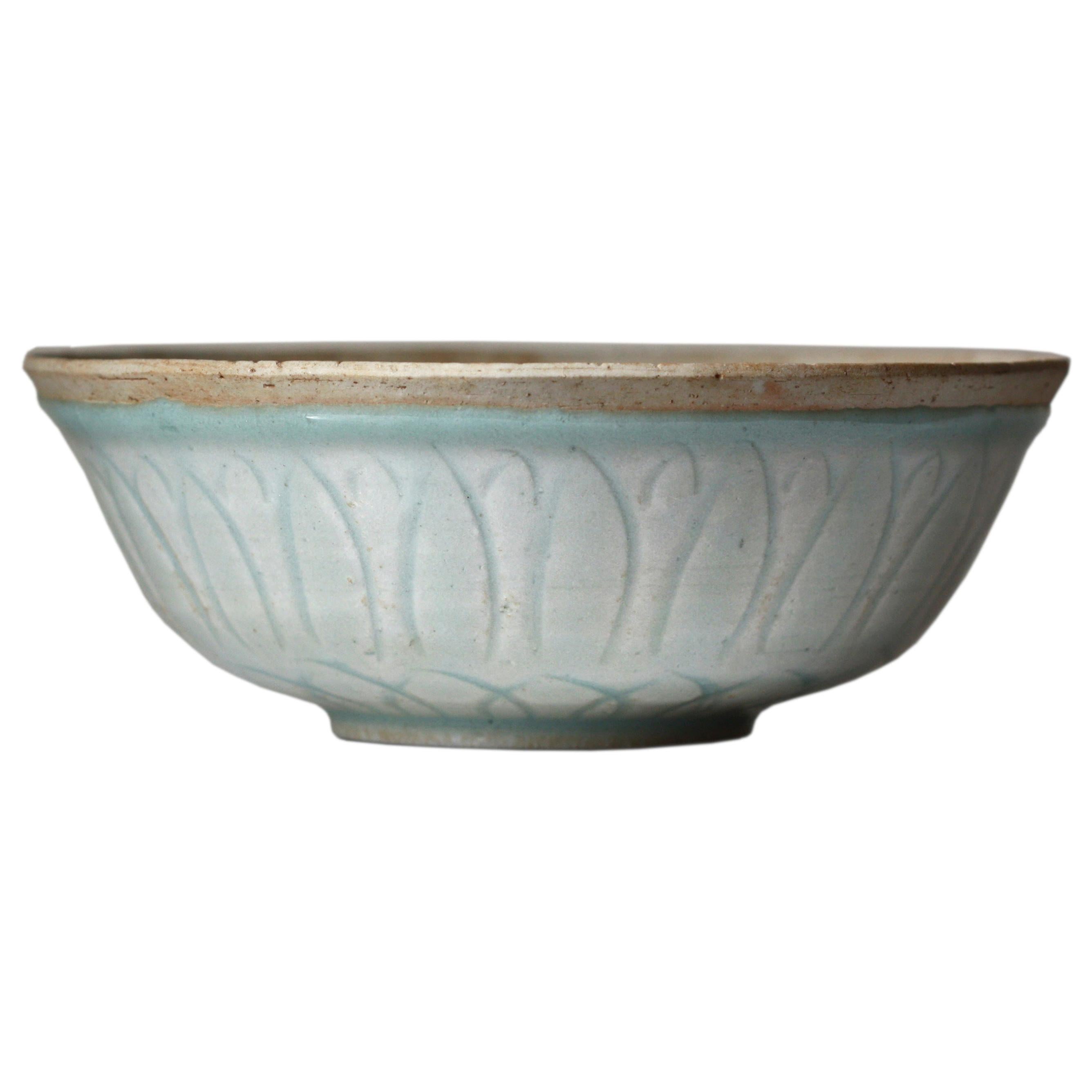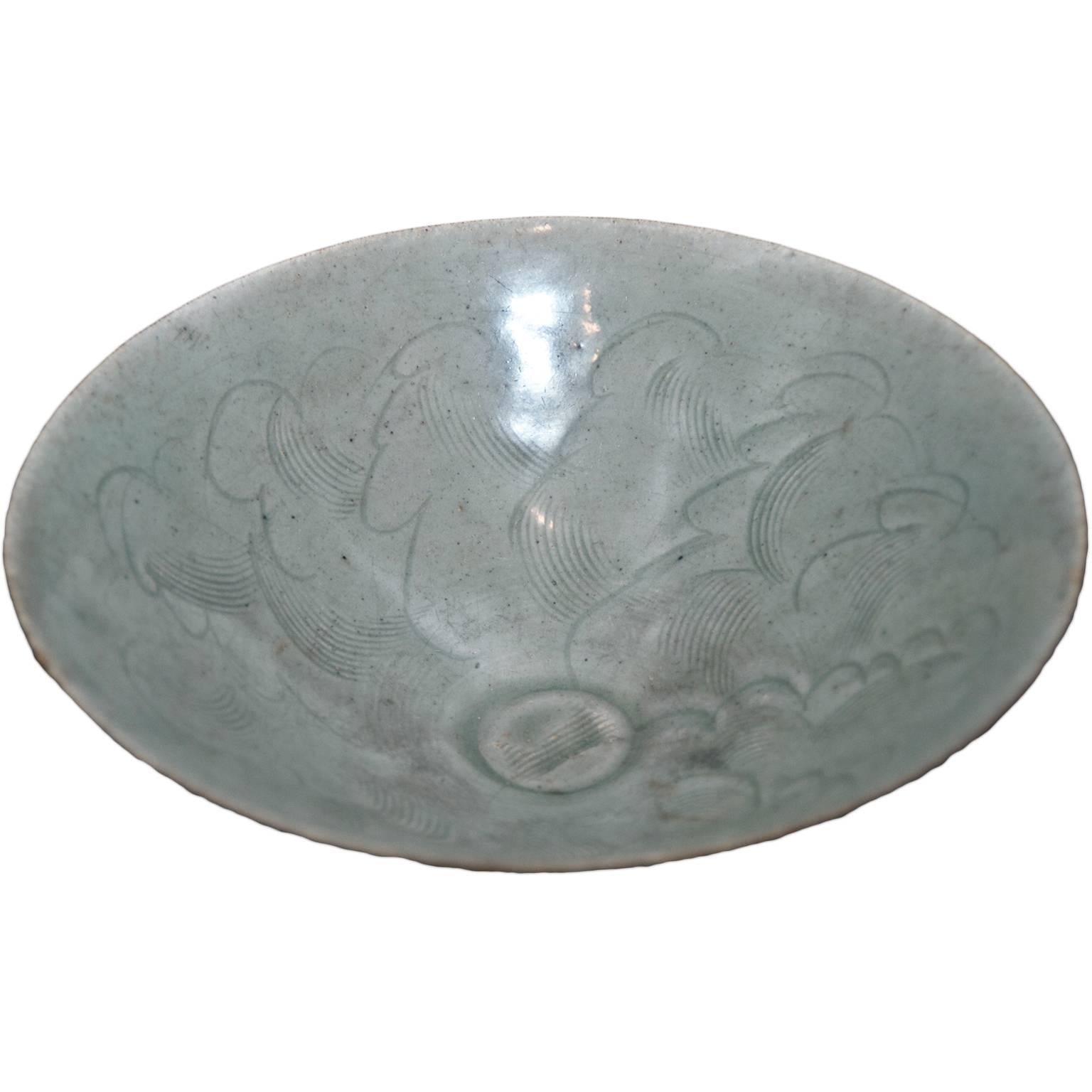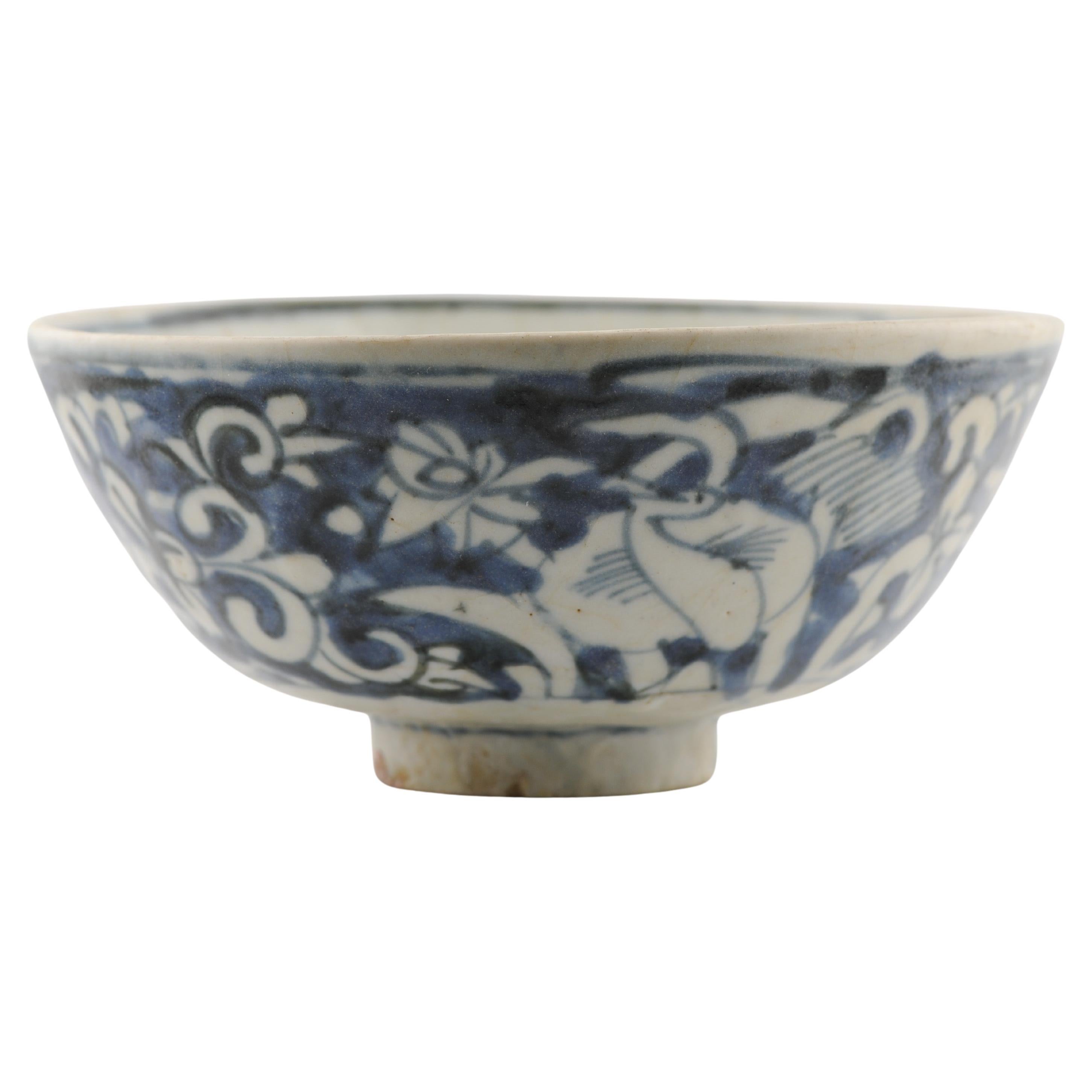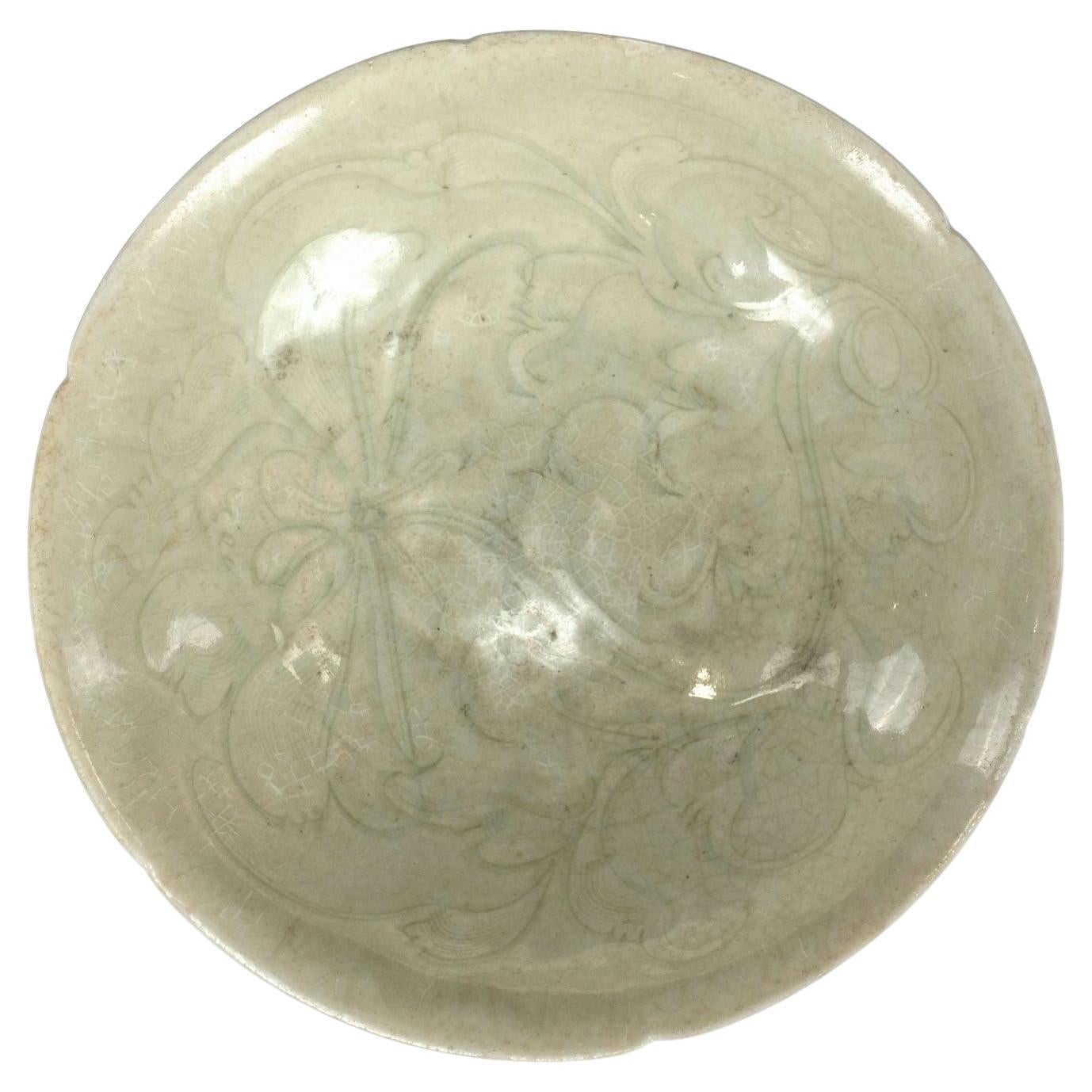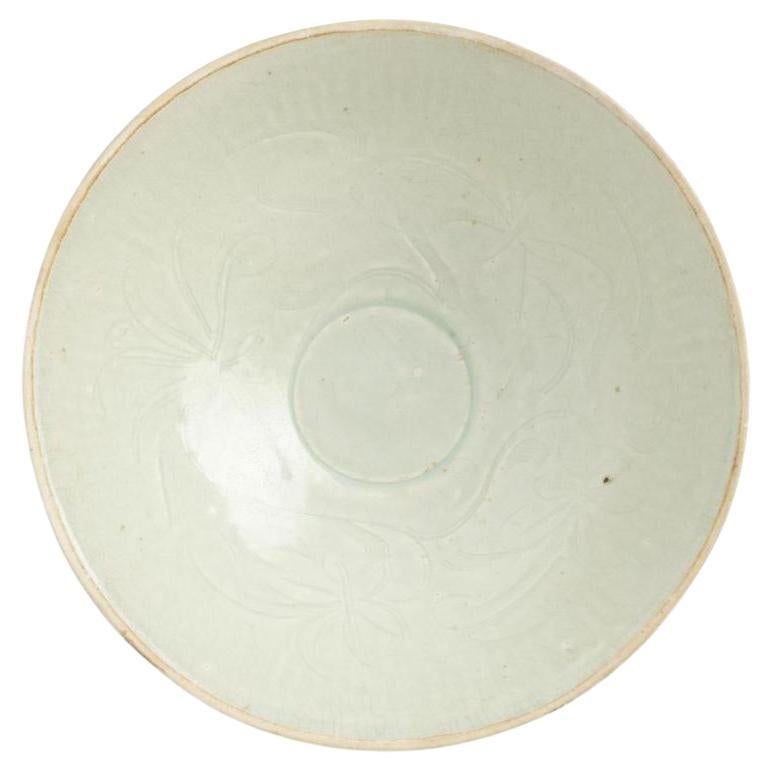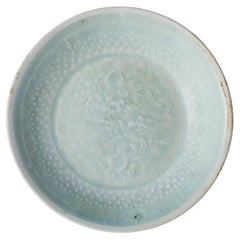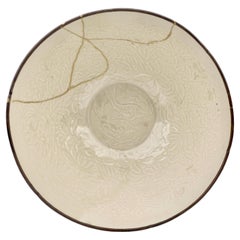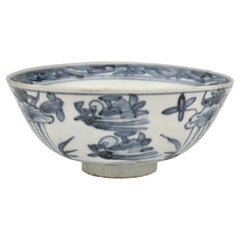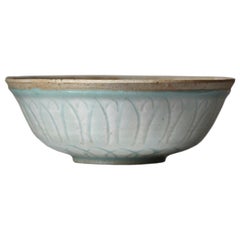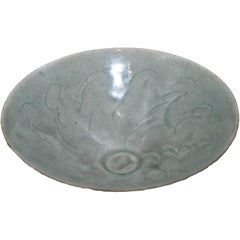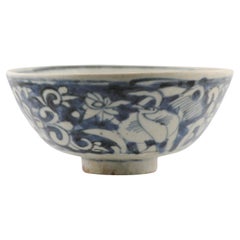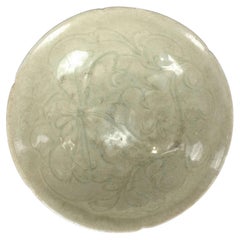Items Similar to Qingbai Bowl with carving of crane, Song Dynasty
Want more images or videos?
Request additional images or videos from the seller
1 of 8
Qingbai Bowl with carving of crane, Song Dynasty
$1,192
$1,49020% Off
£904.46
£1,130.5820% Off
€1,034.17
€1,292.7120% Off
CA$1,664.90
CA$2,081.1320% Off
A$1,851.14
A$2,313.9320% Off
CHF 966.56
CHF 1,208.2120% Off
MX$22,532.92
MX$28,166.1520% Off
NOK 12,332.95
NOK 15,416.1820% Off
SEK 11,555.38
SEK 14,444.2320% Off
DKK 7,718.21
DKK 9,647.7720% Off
Shipping
Retrieving quote...The 1stDibs Promise:
Authenticity Guarantee,
Money-Back Guarantee,
24-Hour Cancellation
About the Item
The crane, a traditional symbol of longevity and auspiciousness, is prominently placed at the center, creating a harmonious and aesthetically balanced effect. The border of the dish is decorated with simpler patterns, accentuating the central crane motif. Qingbai ware is a distinctive type of Chinese ceramic that flourished during the Song period, characterized by its translucent glaze that often reveals incised or relief decorations underneath. This particular dish exemplifies the high level of craftsmanship and premium materials required at the time, featuring delicate carvings and a soft, lustrous glaze.
Period : Song Dynasty(1271-1368)
Type : Bowl
Medium : Qingbai
Size : 7.0 cm(Height), 15cm(Diameter)
Condition : Good(There are crack on the edge)
Provenance : Acquired in late 1990s from Hongkong
Reference : Sotheby's Newyork 26 September 2023 - CHINA / 5000 YEARS - Lot1361
(Price Range : 3,000 - 5,000 USD / Type : Closely related)
* Qingbai Ware
Qingbai ware, which translates to "blue-white ware," is a type of Chinese porcelain that was made at the Jingdezhen and other kilns in the porcelain-producing regions of China, primarily during the Song dynasty (960–1279) and continuing into the Yuan dynasty (1271–1368). It is known for its translucent quality and the pale blue-green glaze that characterizes most of its pieces.
The qingbai glaze was achieved using a small amount of iron in a reduction-fired atmosphere, which produced the subtle blue-green tint. The body of qingbai ware is typically made of a fine, white porcelain that is often referred to as 'artificial jade' due to its resemblance to the esteemed stone. The thinness of the body and the high firing temperatures used contributed to the translucent quality of the finished product.
Qingbai ware includes a range of items such as bowls, cups, vases, and ewers. The designs are usually simple and elegant, with an emphasis on the graceful lines and form of the objects. Decorative motifs, when present, are often incised, carved, or molded in relief and can include floral patterns, dragons, phoenixes, and other symbolic elements drawn from Chinese culture.
Over time, the technology and techniques used to produce qingbai ware evolved, leading to innovations in glaze and decoration that would influence later types of Chinese porcelain. Despite these changes, qingbai ware remains a distinguished example of the potters' art in Song and Yuan China, reflecting the refined aesthetic and cultural values of the period.
- Dimensions:Height: 2.76 in (7 cm)Diameter: 5.91 in (15 cm)
- Style:Chinese Export (Of the Period)
- Materials and Techniques:Porcelain,Unglazed
- Place of Origin:
- Period:
- Date of Manufacture:1271-1368
- Condition:Minor fading. brown color crack on the upper edge, the part has been repaired and is safe.
- Seller Location:seoul, KR
- Reference Number:1stDibs: LU9577238541662
About the Seller
4.8
Gold Seller
Premium sellers maintaining a 4.3+ rating and 24-hour response times
Established in 1999
1stDibs seller since 2023
38 sales on 1stDibs
Typical response time: <1 hour
- ShippingRetrieving quote...Shipping from: seoul, Korea South
- Return Policy
Authenticity Guarantee
In the unlikely event there’s an issue with an item’s authenticity, contact us within 1 year for a full refund. DetailsMoney-Back Guarantee
If your item is not as described, is damaged in transit, or does not arrive, contact us within 7 days for a full refund. Details24-Hour Cancellation
You have a 24-hour grace period in which to reconsider your purchase, with no questions asked.Vetted Professional Sellers
Our world-class sellers must adhere to strict standards for service and quality, maintaining the integrity of our listings.Price-Match Guarantee
If you find that a seller listed the same item for a lower price elsewhere, we’ll match it.Trusted Global Delivery
Our best-in-class carrier network provides specialized shipping options worldwide, including custom delivery.More From This Seller
View AllA Molded Qingbai 'Flowers' Dish, Southern Song Dynasty
Located in seoul, KR
The plate depicted here exhibits the intricate floral patterns and lotus motifs that are typical of Southern Song designs. The central floral motif captures the essence of Oriental b...
Category
Antique 15th Century and Earlier Hong Kong Antiquities
Materials
Ceramic
$1,560 Sale Price
60% Off
A Rare Moulded Dingyao 'Cranes And Fishes' Bowl, Northern Song - Jin Dynasty
Located in seoul, KR
This bowl stands out for its detailed depiction of two fish amid soft spiral waves, bordered by two cranes within the bowl. The design's depth and clarity, from the lifelike portrayal of the landscape to the cranes' meticulously detailed features, render this piece exceptionally unique and rare. Such complex designs on bowls were achieved using a mold, a method initiated at the Ding kilns in the late 11th or early 12th century, enabling heightened precision. These molds, akin to those for metal vessel casting, reflect a shared design aesthetic with contemporary metal objects.
Period : Northern Song-Jin dynasty(960~1234)
Type : Dingyao
Provenance : Acquired in late 1990s, Hongkong
Dimension : 19 cm(Height) x 8cm(Diameter)
Reference :
1) Sotheby's Hongkong 29 April 2022 - Important Chinese Art including Jades from the De An Tang Collection and Gardens of Pleasure - Lot 3695, Lot 3603
(Price : 1,890,000 HKD / Type : Closely related)
2) Sotheby's Hongkong 08 October 2019 Important Chinese Art - lot 3612
(Price : 3,000,000 HKD / Type : Related)
3) Sotheby's Hongkong 22 April 2021 - Monochrome III - Lot 30
(Price : 6,000,000-7,000,000 HKD / Type : Related)
4) The MET - Accession Number: 14.40.155 - Bowl with Peonies
(Type : Closely Related)
* Song Dynasty Ding-Yao Ware
Song Dynasty Ding Yao porcelain holds a significant place in Chinese ceramic art, specifically as a type of white porcelain produced during the Song Dynasty. Produced predominantly during the mid to late Song Dynasty, Ding Yao ceramics are renowned for their delicate and intricate features.
Ding Yao ceramics were primarily crafted from clay rich in white minerals and fired at high temperatures to achieve a durable and lustrous surface. One distinctive characteristic of this serene white ceramic is the presence of silver or gold-colored splashes of glaze, often created using a mineral called galena. Galena, with its lustrous appearance, was suitable for creating fine patterns and intricate decorations.
These ceramics frequently feature delicate carvings, floral motifs, or subtle decorations. While commonly used for utilitarian purposes such as tableware, Ding Yao porcelain also served as a medium for artistic expression, producing many artworks. The production of Ding Yao ceramics was relatively limited, and surviving pieces are considered rare and valuable art pieces...
Category
Antique 15th Century and Earlier Hong Kong Antiquities
Materials
Ceramic, Porcelain
$23,960 Sale Price
60% Off
Qingbai Floriform Dish, Song-Yuan Dynasty
Located in seoul, KR
The dish has a scalloped rim, which gives it a flower-like appearance. The wavy edges are characteristic of the Song dynasty ceramics, often inspired by natural forms such as flowers...
Category
Antique 15th Century and Earlier Hong Kong Antiquities
Materials
Ceramic
$2,686 Sale Price
55% Off
Bowl with mandarin duck and lotus pattern design, Late Ming Era(16-17th century)
Located in seoul, KR
Bowl from the late Ming dynasty cargo. An identical piece is included on page 136 of the Bin Thuan catalog titled 'The Age of Discovery: Asian Ceramics Found...
Category
Antique 16th Century Vietnamese Ming Decorative Bowls
Materials
Ceramic, Porcelain
Annamese Dish Circa 15th Century, Le Dynasty
Located in seoul, KR
Its surface is coated with a smooth, glossy white or cream-colored glaze, exuding a clean and elegant finish. At the center, a geometric motif painted in black pigment draws the eye,...
Category
Antique 15th Century and Earlier Vietnamese Antiquities
Materials
Stoneware
$1,500 Sale Price
40% Off
Annamese Stoneware Dish with Lotus Motif, 15-16th Century Vietnam, Le Dynasty
Located in seoul, KR
This Annamese ceramic dish features a central lotus motif, enclosed by a thin circular border. The rim is adorned with intertwining vine patterns and swirling motifs. The dish has a gently curved form with a well-proportioned depth and a neatly finished rim.
Dates : 15th century Le Dynasty
Region : North Annam, Vietnam
Type : Dish
Found/Acquired : Southeast Asia , South China Sea, Hoi An Ship
Reference : Double checked with reference to the original catalogue
Butterfield Treasures Hoi An Hoard Auction Catalogs / San Francisco Butterfields 2000
* Vietnamese trade ceramics
Around the mid-14th century, Vietnam developed its ceramics production technology by producing blue and white porcelain, and began to export it overseas. During this period, China Ming Dynasty implemented a policy of lifting the ban from 1371 to 1657 and restricted foreign trade. This served as a good opportunity in the trade history of Vietnamese ceramics, and ceramic exports...
Category
Antique 15th Century and Earlier Vietnamese Ming Antiquities
Materials
Stoneware
$1,393 Sale Price
30% Off
You May Also Like
Qinqbai Lobed Conical Bowl, Chinese Probably Song Dynasty
Located in West Palm Beach, FL
A Qinqbai lobed conical bowl, Chinese,
probably Song Dynasty
Measures: Height 1 in. (2.54 cm.), diameter 5.06 in. (12.85 cm.)
Category
Antique 19th Century Ceramics
Materials
Ceramic
Little Circular Chinese Stoneware Bowl Sung 1 Period, 12th-14th Century
Located in Roma, IT
A circular glazed stoneware adorned with cloud engravings.
12th-14th century – Sung period.
This object is shipped from Italy. Under existing legislation...
Category
Antique 15th Century and Earlier Chinese Serving Bowls
Materials
Stoneware
Antique Ming Wanli 1560-1590 Chinese Porcelain Swatow/Zhangzhou Bowl
Located in Amsterdam, Noord Holland
A Chinese blue and white porcelain bowl with cranes and flowers.
end of the 16th century. Swatow
——————————————————————————————————————
Condition
2 chips to rim and crackle lines. ...
Category
Antique 17th Century Chinese Ming Ceramics
Materials
Porcelain
Chinese Qingbai Lobed Foliate-Rim Bowl, Song Dynasty
Located in Houston, TX
Chinese Qingbai lobed foliate-rim bowl, Song Dynasty, porcelain shallow bowl resting upon tapered footed base. Peony flower decoration incised upon interior of bowl. Known colloquial...
Category
Antique 15th Century and Earlier Chinese Decorative Bowls
Materials
Earthenware
A Chinese Qingbai Incised Flower Bowl, Song Dynasty, Ex Christie's
Located in ARMADALE, VIC
A Chinese Qingbai Incised Flower Bowl, Song Dynasty, Ex Christie's
Provenance: Private Melbourne Collection. Christie's Melbourne, 6/7/1999, lot 638.
Dimension: Height: 6.2cm Diam...
Category
Antique 15th Century and Earlier Chinese Ceramics
Materials
Porcelain
Stoneware Chinese Bowl, Sung Period, 12th-14th Century
Located in Roma, IT
Little stoneware Chinese bowl in glazed stoneware. It is adorned with flower engravings.
Under the base, we can read “Xia Fang'' & ''Ding Hai”.
12th-...
Category
Antique 15th Century and Earlier Chinese Serving Bowls
Materials
Stoneware
More Ways To Browse
Antique Crane
Song Dynasty
Chinese Song Dynasty
Asian Cranes
Green Stone Carving
Song Dynasty Furniture
Blue Crane
Dynasty Bowl
Chinese Crane
Chinese Bowl Small
Song Porcelain
Antique Fire Bowl
Antique Stone Bowl
Chinese Green Bowl
Chinese Blue White Bowl
Chinese Porcelain Small Bowl
Song Dynasty Vase
Thin Porcelain Chinese
